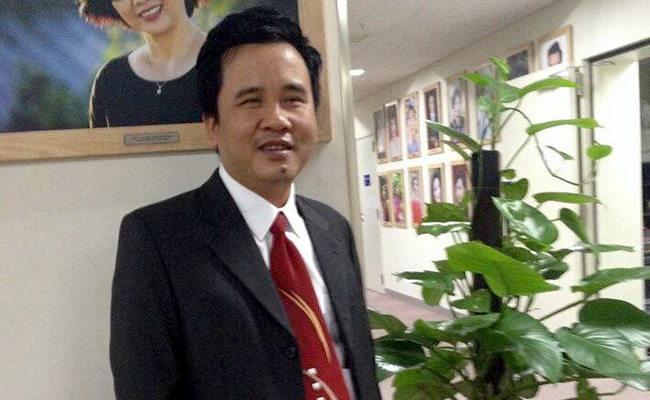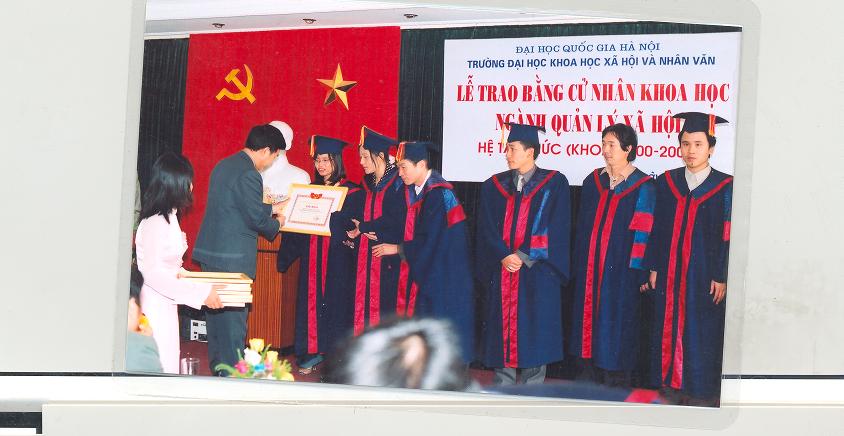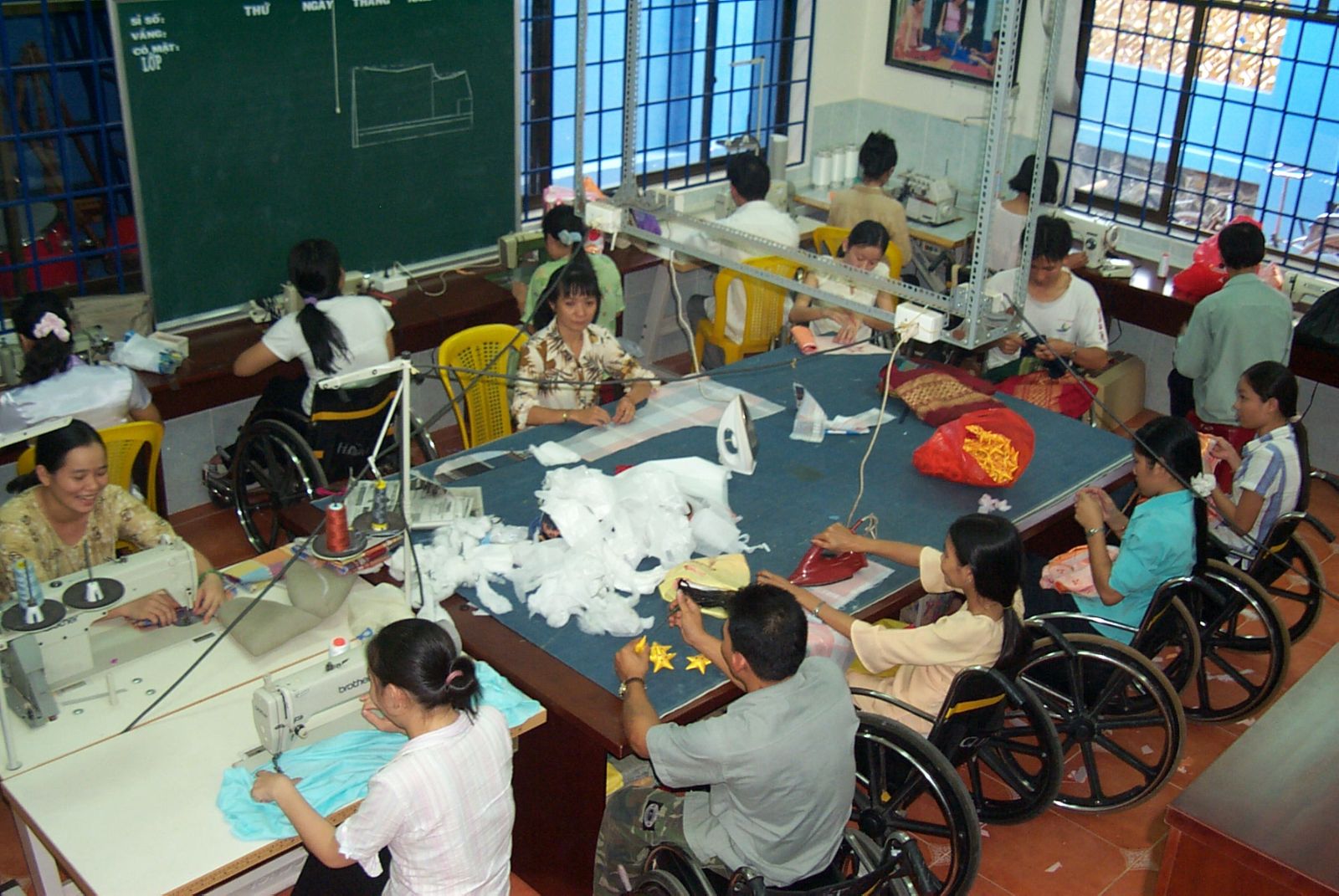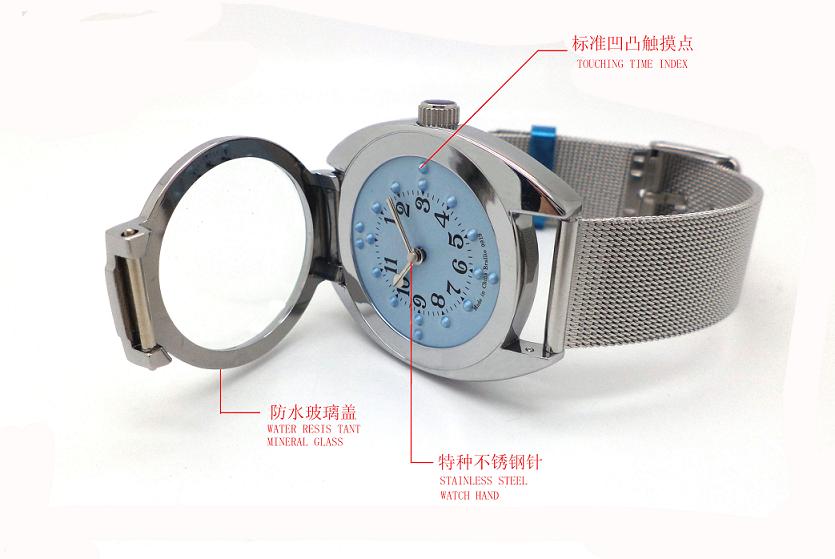tin tức nổi bật
-
 Hoàng Xuân Hạnh - Hoàng Kim: Doanh nhân người khiếm thị được biểu dương năm 2018
Hoàng Xuân Hạnh - Hoàng Kim: Doanh nhân người khiếm thị được biểu dương năm 2018
-
 Tôi mách bạn 6 Giải pháp hàng đầu để trở thành chuyên gia trong trị liệu: chữa bệnh và làm đẹp
Tôi mách bạn 6 Giải pháp hàng đầu để trở thành chuyên gia trong trị liệu: chữa bệnh và làm đẹp
-
 Hoàng Kim Massage thông kinh lạc toàn thân thải độc tố cơ thể, phục hồi sức khỏe, thổi bay những cơn đau bằng Công nghệ điện sinh học DDS
Hoàng Kim Massage thông kinh lạc toàn thân thải độc tố cơ thể, phục hồi sức khỏe, thổi bay những cơn đau bằng Công nghệ điện sinh học DDS
-
 Tẩm quất người mù Hoàng Kim tổ chức lớp Tập huấn kỹ thuật massage làm đẹp da mặt, massage giảm mỡ bụng cạo gió, giác hơi ống trúc cho nhân viên
Tẩm quất người mù Hoàng Kim tổ chức lớp Tập huấn kỹ thuật massage làm đẹp da mặt, massage giảm mỡ bụng cạo gió, giác hơi ống trúc cho nhân viên
-
Góp máy tính cho người khuyết tật
-
 Chương trình tài trợ 1000 máy xông hơi cho thành viên hội người mù việt nam
Chương trình tài trợ 1000 máy xông hơi cho thành viên hội người mù việt nam
-
.jpg) Những ngón tay dệt nên thần thoại
Những ngón tay dệt nên thần thoại
-
 Quyển sách: Món ngon ngày tết
Quyển sách: Món ngon ngày tết
-
 Giám đốc Trung tâm Hoàng Kim được ghi nhận là thành viên tích cực của Hiệp hội thương mại điện tử Việt Nam (năm 2012)
Giám đốc Trung tâm Hoàng Kim được ghi nhận là thành viên tích cực của Hiệp hội thương mại điện tử Việt Nam (năm 2012)
-
video người mù vượt qua bóng tối (P1) (năm 2012)
-
 Giới thiệu 2: Đĩa âm nhạc tẩm quất người mù Hoàng Kim
Giới thiệu 2: Đĩa âm nhạc tẩm quất người mù Hoàng Kim
-
Tuyển dụng nhân viên làm tẩm quất ở Hoàng Kim
-
 Người giàu không ở... hai con mắt
Người giàu không ở... hai con mắt
-
Biển tẩm quất người mù bị trịch thu vì ảnh hưởng đến làng văn hóa
-
 Những ngón đàn xuyên suốt màn đêm
Những ngón đàn xuyên suốt màn đêm
-
.jpg) Hoàng kim trước thềm xuân mới.
Hoàng kim trước thềm xuân mới.
-
 Massage của người khiếm thị từ góc nhìn của một người “ngoại đạo”
Massage của người khiếm thị từ góc nhìn của một người “ngoại đạo”
-
 Xoa xát mắt để phòng cận thị và hoa mắt ở tuổi già
Xoa xát mắt để phòng cận thị và hoa mắt ở tuổi già

UNIT 4: CIVIL SERVICE MANAGEMENT (1)
- WARM-UP
Activity 1:
In groups of five, discuss the meaning of civil service management.
Activity 2: Group discussion
Describe the civil service management in Vietnam.
- TEXTS AND PRACTICE
Activity 3: Pre-reading of Text 1
Make sure you know the meaning of the following words or pharases. Use your dictionary if necessary and then fill in the gaps:
to recruit professional cadres
overstaffing cutting down the staff
early retirement positions
benefits
1. …………….. is one way to reduce numbers of employees.
2. They have a vacancy for a secretary. It is necessary ……………… a new one.
3. Income of civil servants usually comprises of monthly salary and other kinds of ……………..
4. When you have too many people to do the work needed, this creates the problem of …………………….
5. ……………………. Are jobs of paid employment that people hold in an office or organization, especially in the public sector.
6. I think ……………….. are engineers, accountants, doctors and people like these.
7. When there is too much staff in the civil service, governments use ………………… as a measure to reduce the size and cots.
Activity 4: Text 1
Read the following text to get the general understanding of it:
Some Issues in Civil Service Management
- An important aspect of effective Public Administration is efficient managenment of human resources throung an appropriate civil service system. Indeed the needs to recruit, develop and utilized professional managerial cadres to conduct the core government function become pressing as the public service becomes focuses on strategically oriented activities of the state. An overall focus on improved management of human resources, as well as improved development of those human resources, is an essential element. Governments must decide how the staff will be organized, managed, recruited and selected, compensated, trained, evaluated and prometed. Therefore the issues should be addressed through coherent policies, which should be carried out in conformity with national development strategies. Firstly, the governments should re-define the role of the public sector in the light of its political objectives, its resources and the real capacity of its public service.
- At present, many governments are faced with the problems of overstaffing and inefficiency in performance of their civil servant. In order to sovle the problems, various governments have been using different interventions to reduce the cost and the size of the public service. Yet the measures they used, such as cutting down the staff, recruitment through competitive examination, reorganization and early retirement have some considerable results. But in fact, these initiatives have generally been ad hoc. There should be systematic policy orientation later on. The government will have to do more with fewer but better qualified and motivated human resources. The civil service needs to focus on achieving programmed goals.
-
There are two systems of service in the world:
- Career system,
- Job system.
Some of the directions to reform civil service are sa follows:
- Defining the kind of needs for knowledges, skills and abilities.
- Clarifying the categories of government employees to be included in the civil service system.
- Strengthening the role of the agencies responsible for civil service management.
- Classifying the mechanism to designate levels, responsibilitities, and positions.
- Methods for recruitment and selection of public servants.
- And appropriate system of salary, benefits, allowances etc., including the conditions of work.
- Training public servants, including pre-service training, in-service training and career development programs.
- Finally, there should be well-established mechanisms for performance evaluation.
Activity 5: What is the main idea?
Read again to find out the most important ideas in each paragraph:
Paragraph 1: ………………………………………………………………………………………………………………………………………………………………………………………………………………………………………………………………………………
Paragraph 2: ………………………………………………………………………………………………………………………………………………………………………………………………………………………………………………………………………………
Paragraph 3: ………………………………………………………………………………………………………………………………………………………………………………………………………………………………………………………………………………
Activity 6: Vocabulary work
Match the words or phrases on the left with their definitions on the right:
|
|
|
|
|
|
|
|
|
|
|
|
|
|
Activity 7: Multipe choice
Choose the answer that best completes the meaning of the phrase:
- Governments must decide how the staff
- Will be organized, managed, recruited and selected;
- Will be compensated, trained, evaluated and promoted;
- Will be looked after;
- a and b.
- A number of measures have been undertaken by governments in their efforts to reform the civil service, including
- Overstaffing and inefficiency in performance of their civil servants;
- Cutting down the staff, recruitment through competitive examinations, reorganization and early retirement;
- The role of the public sector in the development process;
- To focus on achieving planned goals.
- The following are the forms of civil service systems in the world:
- Career system
- Job system
- Cadre system
- All the above
- Some of the directions to reform the civil service are:
- Defining the needs for civil service, clarifying the categories of employees to be included, strengthening the role of HRM, appropriate methods for selection, recruitment, promotion, salary, training and evaluation;
- Measures for cutting down the staff;
- Pre-service training, in-service training and career development programs for the staff;
- Code of conduct and management by objective.
Activity 8: Work in pairs
Now discuss in pairs and then tell the whole class about civil service reform measures that the Government of Vietnam undertakes, using your own words and phrases.
Activity 9: Pre-reading of Text 2
Match the words on the left with their equivalents on the right:
|
|
|
|
|
|
|
|
|
|
|
|
|
|
|
|
|
|
|
|
Activity 10: Text 2
Skim through the text and write down its topic:
TOPIC:
…………………………………………………………………………………..…..
- in order to have a public service that is highly competent, non-partisan and representative of Canadian society, great importance is attached to the staffing process. The main principles of hiring public servants are set out in the Public Service Employment Act. The Act requires that all appointments be made on the basis of merit. This means that the most qualified person or the one who best meets the standard of competence for a position should be appointed. The responsibility for selecting candidates and appointing staff lies with the Public Service Commission, departmental deputy heads and human resources specialists.
- The staffing process goes through several phases. The first one is the preparation phase. Here the main task is to define the nature of the vacant position (what kind of work is to be performed, the level of responsibility it requires, the context in which duties will be carried out, etc.), and then to specify, the qualifications needed. Usually the following types of qualifications are considered: knowledge, skills, experience, education, previous performance, inter-personal relationships, official language proficiency as well as reliability and medical suitability. The next step is to choose means by which qualifications of candidates will be assessed (interviews, simulations, written test, ect.).
- The second phase in the staffing process is the priorities phase. Certain persons are given priority consideration; for example, surplus employees or those returning from leave. Such people are appointed during this phase, if they are found qualified.
- During the recruitment and selection phase, it is determined whether it will be better to fill the vacancy through an internal selection process or to invite candidates from outside. Then, to ensure a broad area of selection, the position is advertised in newspapers and magazines as well as by means of Internet and email. Next a selection board is set up and the process of screening and assessing candidates begins.
- Following the competition, appointment are made from eligibility lists, which rank candidates in order of merit. This is called the appointment phase. All candidates that took part in the competition receive post-selection feeldback. They are informed in writing about the result of the competition and they have the right to obtain further information about the selection process if they wish. Unsuccessful candidates or persons adversely affected by a staffing decision may appeal the selection, and an investigation will be conducted.
- Public Service Employment Regulations prescribe that employees who are appointed from outside the Public Service should undergo a probation period of 12 months.
Ý kiến độc giả
Các tin liên quan
- UNIT 1: ADMINISTRATION – PUBLIC ADMINISTRATION (1)
- UNIT 1: ADMINISTRATION – PUBLIC ADMINISTRATION (2)
- UNIT 2: GOVERNANCE AND PUBLIC ADMINISTRATION (1)
- UNIT 2: GOVERNANCE AND PUBLIC ADMINISTRATION (2)
- UNIT 3: DEFINING MANAGEMENT (1)
- UNIT 3: DEFINING MANAGEMENT (2)
- UNIT 4: CIVIL SERVICE MANAGEMENT (2)
- UNIT5: PUBLIC ADMINISTRATION REFORM (1)
- UNIT5: PUBLIC ADMINISTRATION REFORM (2)
Ảnh & vi deo sự kiện
-

Dự án tài trợ máy xông hơi cho Hội ng...
-

Hoàng Kim ra mắt Công ty cổ phần tư v...
-
Sinh nhật Website Hoàng Kim tròn 1 tu...
-

Tẩm quất người mù Hoàng Kim với công...
-
Kỷ niệm ngày người khuyết tật Việt na...
-
.jpg)
Tổng kết năm 2010 của Trung tâm Hoàng...
-
Tin nhanh
-
.jpg)
Sản phẩm - Dịch vụ
-
Khách hàng thân thiện
-

Nhân viên Hoàng Kim
tin tức mới
-
 Hoàng Xuân Hạnh - Hoàng Kim: Doanh nhân người khiếm thị được biểu dương năm 2018
Hoàng Xuân Hạnh - Hoàng Kim: Doanh nhân người khiếm thị được biểu dương năm 2018
-
 Doanh nhân khiếm thị tâm huyết / Chàng trai khiếm thị thành lập doanh nghiệp hỗ trợ nghề
Doanh nhân khiếm thị tâm huyết / Chàng trai khiếm thị thành lập doanh nghiệp hỗ trợ nghề
-
 Tôi mách bạn 6 Giải pháp hàng đầu để trở thành chuyên gia trong trị liệu: chữa bệnh và làm đẹp
Tôi mách bạn 6 Giải pháp hàng đầu để trở thành chuyên gia trong trị liệu: chữa bệnh và làm đẹp
-
 Giáo trình dạy học DDS – Điện sinh học
Giáo trình dạy học DDS – Điện sinh học
-
 Ưu thế nổi bật của công nghệ DDS – Điện sinh học trong chữa bệnh và làm đẹp
Ưu thế nổi bật của công nghệ DDS – Điện sinh học trong chữa bệnh và làm đẹp
tin tức xem nhiều
-
 Hoàng Kim Massage thông kinh lạc toàn thân thải độc tố cơ thể, phục hồi sức khỏe, thổi bay những cơn đau bằng Công nghệ điện sinh học DDS
Hoàng Kim Massage thông kinh lạc toàn thân thải độc tố cơ thể, phục hồi sức khỏe, thổi bay những cơn đau bằng Công nghệ điện sinh học DDS
-
 Xoa xát mắt để phòng cận thị và hoa mắt ở tuổi già
Xoa xát mắt để phòng cận thị và hoa mắt ở tuổi già
-
 Dịch vụ đăng quảng cáo đặt Banner giá rẻ - Hiệu quả bất ngờ
Dịch vụ đăng quảng cáo đặt Banner giá rẻ - Hiệu quả bất ngờ
-
 Massage của người khiếm thị từ góc nhìn của một người “ngoại đạo”
Massage của người khiếm thị từ góc nhìn của một người “ngoại đạo”
Ủng hộ từ thiện







.JPG)

.JPG)








Bình luận